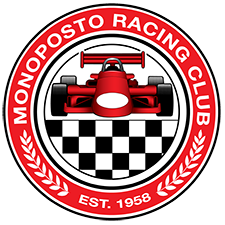Classes
In order to maintain fairness, when dealing with a diverse range of cars from the early 1980's or earlier to cars less than 10 years old, Monoposto has multiple classes to ensure that drivers are competing for championships against cars of broadly similar specifications, ages, power and performance.
Each car is asked to display idenfication stickers denoting their class - these take the form of a coloured shape, located adjacent to the race number, that is clearly visible from a distance.
The current classes are shown below:-
Monoposto Classes
 Mono F3 A, is for the newest generation of F3 car which are most likely to be powered by a F3 specification engine.
Mono F3 A, is for the newest generation of F3 car which are most likely to be powered by a F3 specification engine.
2008-2011 Formula 3 cars with F3 engine
2005-2007 Formula 3 cars with F3 engine
2006-2008 Formula Renault without restrictor with paddle shift if desired
For full information, please consult the technical regulations.
Caveat: These details are an outline and the current club regulations must be referred to for full detailed requirements.
Class Identification - Red Circle with white A superimposed

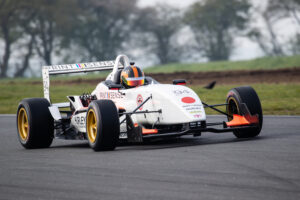 Mono F3 B,
Mono F3 B,
1997-2011 Formula 3 cars with traditional Mono spec road derived engine
1997-2004 Formula 3 cars with F3 engine
1997-2011 Formula 3 cars with Piedrafieta Toyota engine
2006-2007 Formula Renault with 40mm restrictor, but with paddle shift if desired
2014-2021 Mygale F4 / Ecoboost cars
Tatuus (Gen1) F4 cars
For full information, please consult the technical regulations.
Caveat: These details are an outline and the current club regulations must be referred to for full detailed requirements.
Class Identification - Red Circle

 Mono 2000 evolved out of Mono Classic 2000 for the 2016 season, this class is for cars that fit between the Classic and Mono F3 classes.
Mono 2000 evolved out of Mono Classic 2000 for the 2016 season, this class is for cars that fit between the Classic and Mono F3 classes.
Typically 750MC F4, US FF2000 or 1996 and earlier Formula 3 chassis.
Spaceframe or aluminium monocoque chassis from 2001 or earlier. Formula Renault cars from 1999 or earlier and carbon tubbed Formula 3 cars from 1996 or earlier.
Standard production engines up to 2000cc capacity. Dry sump lubrication permitted. Flywheel free. Carburettors or throttle body fuel injection. Ford Zetec engines can have free cam timing (retaining standard camshaft and pulley).
Engines of manufacture and model as used in FIA international Formula 3 during 1996 or earlier, have an air restrictor of 25mm diameter through which all air is passed. For full information, please consult the technical regulations.
Caveat: These details are an outline and the current club regulations must be referred to for full detailed requirements.
Class Identification - Green Circle

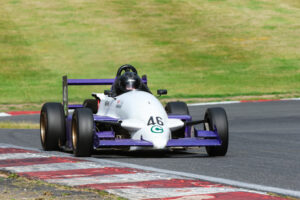 Mono Classic 2000 is a popular class for classic cars such as Formula Vauxhall Lotus and older F3 cars, like Reynards and Ralts.
Mono Classic 2000 is a popular class for classic cars such as Formula Vauxhall Lotus and older F3 cars, like Reynards and Ralts.
Chassis of aluminium alloy and/or steel construction where the manufacturer's designated model year is 1993 or earlier.
Chassis of carbon fibre composite or aluminium alloy construction originally complying, or derived from those originally complying, with FIA Formula 3 and identified by the manufacturer as for the model year 1992 or earlier.
Standard production engines up to 2000cc capacity. Dry sump lubrication permitted. Steel flywheel minimum weight 3.6kg. carburettors or original spec fuel injection.
Engines of manufacture and model as used in FIA international Formula 3 during 1992 or earlier, having a 24 or 25 millimetre maximum diameter air restrictor through which all air serving the induction is passed. Car with electronic fuel injection have to use a 24mm restrictor, cars with mechanical fuel injection are permitted to use a 25mm restrictor.
For full information, please consult the technical regulations.
Caveat: These details are an outline and the current club regulations must be referred to for full detailed requirements.
Class Identification - Green Circle with White 'C'

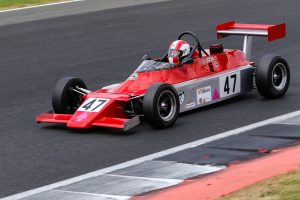 Mono 1800 features Formula Ford Duratec, Formula Ford Zetec, Classic FF2000, Formula Vauxhall Junior (16V) and Formula Ireland cars.
Mono 1800 features Formula Ford Duratec, Formula Ford Zetec, Classic FF2000, Formula Vauxhall Junior (16V) and Formula Ireland cars.
Engines conforming to the following regulations: FF Zetec 1800cc, Formula Vauxhall Junior 16V, FF2000 as defined in the 1993 MSA yearbook and FF Duratec.
For full information, please consult the technical regulations.
Caveat: These details are an outline and the current club regulations must be referred to for full detailed requirements.
Class Identification - Pink Triangle

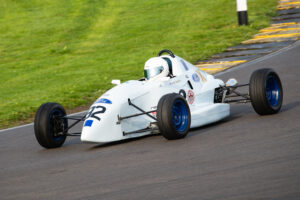 Mono 1600 is for cars such as Formula Ford/FF2000 chassis, Formula Vauxhall Junior (8V) and Formula Renault 1700, and for 2020 season the Scarab Mk V Formula-Vee chassis and VW 1300 engine permitted
Mono 1600 is for cars such as Formula Ford/FF2000 chassis, Formula Vauxhall Junior (8V) and Formula Renault 1700, and for 2020 season the Scarab Mk V Formula-Vee chassis and VW 1300 engine permitted
Standard, iron block engines with a single camshaft up to 1750cc capacity, dry sump permitted. FF Kent 1600 engines, when fitted in older chassis, may use the approved Mono camshaft.
For full information, please consult the technical regulations.
Caveat: These details are an outline and the current club regulations must be referred to for full detailed requirements.
Class Identification - Blue Square

 Mono Moto 1400 is for bike engined cars of engine capacity from 1001 to 1400cc, using either a tubular chassis or a carbon fibre tub. Engines of under 1000cc cars who wish to run a carbon fibre chassis must race in Mono Moto 1400.
Mono Moto 1400 is for bike engined cars of engine capacity from 1001 to 1400cc, using either a tubular chassis or a carbon fibre tub. Engines of under 1000cc cars who wish to run a carbon fibre chassis must race in Mono Moto 1400.
For full information, please consult the technical regulations.
Caveat: These details are an outline and the current club regulations must be referred to for full detailed requirements.
Class Identification - Purple Diamond


Mono Moto 1000 is for bike engined cars such as Jedi F1000, JKS, Speads, Aztec, OMS, homebuilds or conversions of other chassis (non-carbon tubs) with motorcycle sourced engines and gearboxes.
Note: Carbon tubbed chassis must race in Mono Moto 1400, but non-structural components may be carbon fibre (eg wings, engine cover)
For full information, please consult the technical regulations.
Caveat: These details are an outline and the current club regulations must be referred to for full detailed requirements.
Class Identification - Yellow Diamond

Recent Posts
-

2026-02-10: MSVR Season Launch – Donington Park
MSVR will be holding their annual Season Launch... -

2025 Annual Awards Subjective Awards Nominees and Voting Form
The awards and trophies which are given out ann... -

2026-02-07: Mono AGM, Awards Night & Dinner Dance
Page for 2024 Mono AGM and Dinner Dance held on... -
2026-05-02/03: Silverstone GP (Mono 2)
Event page for 2025 Silverstone GP meeting... -
2026-04-04/05: Silverstone International (Mono 1)
Event page for 2025 Silverstone International m...
Featured Posts
-

2026-02-10: MSVR Season Launch – Donington Park
0 comments -

2025 Annual Awards Subjective Awards Nominees and Voting Form
0 comments -

2026-02-07: Mono AGM, Awards Night & Dinner Dance
0 comments -
2026-05-02/03: Silverstone GP (Mono 2)
0 comments -
2026-04-04/05: Silverstone International (Mono 1)
0 comments
